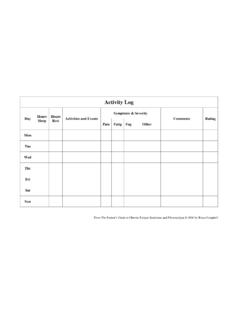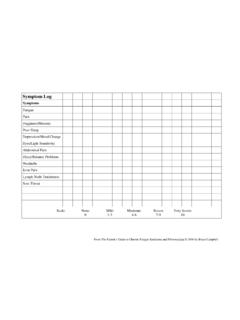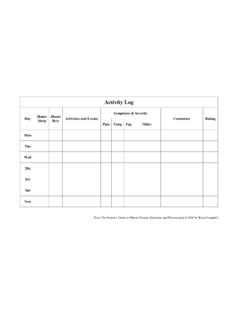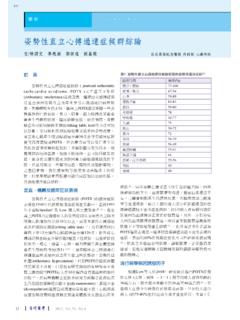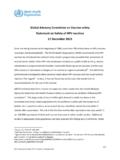Transcription of CFS & Fibromyalgia Workbook: Creating a Self …
1 1 CFS & Fibromyalgia workbook : Creating a Self-Management Plan Introduction 2 1 Understanding Your Situation 3 2 The Energy Envelope 8 3 Pacing Strategies 10 4 Gaining Consistency in Pacing 15 5 Managing Stress 20 Version (Jan 2012) 2012 CFIDS & Fibromyalgia Self-Help Program 2 Introduction Living with CFS and/or Fibromyalgia can feel overwhelming at times, but there are many things you can do to regain control. This workbook focuses on the area likely to produce the biggest gains: lifestyle change, which means adjusting your habits and how you live your daily life. This is a gradual process, changing one or two things at a time, but used consistently it can be transforming. This class focuses on the two areas we believe are the heart of a self-management plan for CFS/FM: pacing and stress management.
2 The next class (Self-Help III: Living Your Plan) offers support for integrating pacing and stress management into your life, and also focuses on other areas, such as treating symptoms, managing emotions, reworking relationships and Creating a new life in response to loss. Two disclaimers before we begin. First, this workbook will not make you better. Only you can do that. The workbook will give you the tools for feeling better and the class will offer you support, but you have to do the work. Second, learning to live well with a long-term illness requires hard work, determination and patience. You will probably feel discouraged at times. When that happens, we hope you remember that many people before you have had similar feelings and have gone on to improve, one step at a time.
3 The keys to improvement are a willingness to adapt and consistent use of the tools of self-management, especially pacing and stress management. 3 Chapter 1: Understanding Your Situation When you develop a long-term condition like Chronic Fatigue Syndrome or Fibromyalgia , you may feel like you have entered a new world in which all the rules of life have changed and there is no obvious way forward. This perplexing situation can make you feel helpless. But there are many things you can do to regain control and improve your well being. This workbook will show you how. Using the ideas you ll find here, you can create a plan for managing CFS and/or Fibromyalgia . When you first experienced CFS and/or Fibromyalgia , you may have thought you had a short-term illness, but at some point, you were confronted by the fact that your problem was something quite different.
4 Rather than a temporary problem, CFS and FM are conditions that persist. Instead of resuming your previous life after a brief interruption, you were faced with having to adjust to long-term symptoms and limitations. CFS and Fibromyalgia are different in a second way. Not only do they impose limits and bring symptoms that persist, they have comprehensive effects, touching many parts of life. They affect your ability to work, your relationships, your moods, your hopes and dreams for the future, and even your sense of who you are. Living with a long-term condition like CFS or Fibromyalgia means much more than managing symptoms. A plan for managing them has to address all its effects. Third (and perhaps most important), Chronic Fatigue Syndrome and Fibromyalgia are affected by how you respond to them.
5 There is so far no cure for either CFS or Fibromyalgia , but how you respond to your situation has a big effect on symptoms and quality of life, often a larger effect than medical treatments. As Dr. Charles Lapp says, There are limits to what your doctor can do. The key to recovery with these conditions, he says, is acceptance of the illness and adaptation to it by means of lifestyle changes, for which medical treatment is no substitute. Each person with CFS or FM is different, so your self-management plan should fit your unique situation. We begin with exercises to help you understand your individual circumstances. Your CFS/FM (Severity) The severity of CFS and FM varies greatly. Some people s lives are touched lightly, while others have their lives disrupted moderately and still others are housebound or even bedbound.
6 To treat your illness effectively, you need to understand your version of CFS and/or FM. You can get an overall idea of your CFS or FM by placing yourself on the Rating Scale on the next page. Place yourself on the scale by answering the question What is the highest level of functioning I can sustain without intensifying my symptoms? 4 Your rating gives you an idea of the severity of your illness and of the activity level your body can tolerate at present. For example, if you rate yourself at 30 (average for people in our program), your activity level would be about three hours a day. My Self-Rating _____ CFS/ Fibromyalgia Rating Scale 100 Fully recovered. Normal activity level with no symptoms. 90 Normal activity level with mild symptoms at times.
7 80 Near normal activity level with some symptoms. 70 Able to work full time but with difficulty. Mostly mild symptoms. 60 Able to do about 6-7 hours of work a day. Mostly mild to moderate symptoms. 50 Able to do about 4-5 hours a day of work or similar activity at home. Daily rests required. Symptoms mostly moderate. 40 Able to leave house every day. Moderate symptoms on average. Able to do about 3-4 hours a day of work or activity like housework, shopping, using computer. 30 Able to leave house several times a week. Moderate to severe symptoms much of the time. Able to do about 2 hours a day of work at home or activity like housework, shopping, using computer. 20 Able to leave house once or twice a week.
8 Moderate to severe symptoms. Able to concentrate for 1 hour or less per day. 10 Mostly bedridden. Severe symptoms. 0 Bedridden constantly. Unable to care for self. Additional Medical Issues Living with CFS or Fibromyalgia is often complicated by the presence of additional medical problems. Many people have both CFS and FM. Also, CFS and FM are often accompanied by one or more other health issues. Other conditions often found together with CFS and FM include those listed alphabetically below. In addition, people with CFS and FM often experience conditions common to aging, such as arthritis, back and spinal problems, and high blood pressure. 5 Chemical sensitivity Depression Food/digestive issues: Candida (yeast infection), Celiac disease, lactose intolerance Gastroesophageal reflux disease (GERD) Irritable bladder syndrome (interstitial cystitis) Irritable bowel syndrome (IBS) Migraine headaches Myofascial pain syndrome (MPS) Orthostatic problems such as neurally mediated hypotension (NMH) or postural orthostatic tachycardia syndrome (POTS) Prostatitis Restless legs syndrome (RLS) Sleep apnea Temporomandibular joint disorder (TMJ) Thyroid problems Fill in your medical issues below, rating the severity of each from 1 (mild) to 10 (severe).
9 My Medical Issues Severity Severity CFS ____ _____ ____ Fibromyalgia ____ _____ ____ _____ ____ _____ ____ _____ ____ _____ ____ _____ ____ _____ ____ _____ ____ _____ ____ _____ ____ _____ ____ _____ ____ _____ ____ Your Life Situation Just as people with CFS and Fibromyalgia differ in the severity of their medical problems and in the number of illnesses they have, so do they come from many different life situations. Some people with CFS/FM are young; many are middle-aged; some are older. Some are married, while others are single. Some are raising children, while others are empty-nesters. Some are in supportive relationships; others in conflicted ones. Some are financially secure, while others are struggling. Your challenges and the resources you have to deal with them will vary depending on your situation, especially your family circumstances (single or married and stage in life), your finances, your responsibilities (who is dependent on you: children, parents, spouse, grandchildren or others) and your sources of support (family, friends, church or other religious group, etc.)
10 6 Your situation includes two other significant factors: your coping skills and attitude. The good news: these factors can be changed. Research has shown that people can learn effective coping skills for managing long-term illness, either on their own or through self-help classes such as this one. Attitude is also important to living well with long-term illness. The attitude that seems to help is one that is both realistic and hopeful. We call it acceptance with a fighting spirit. People with this attitude combine recognition that life has changed with a conviction that they can find ways to improve. For some examples of the effects of a constructive approach to CFS and FM, see the Success Stories on our website: +Stories. For ideas on how to change your attitude, see the article Optimism, Hope & Control.
